Garment care can be a costly business, but did you know there’s a relatively cheap tool out there that could potentially save you a bundle in dry cleaning bills? No, the tool we’re talking about isn’t a lint roller, which purports to quickly and efficiently clean your garments; instead, we’re talking about a clothes brush, which does everything a lint roller does but better.
Why Should I Ditch the Lint Roller?
Lint rollers have dominated this corner of the market for many years now, but while they do have a lower upfront cost, the better investment, in the long run, is still going to be a clothes brush.
Lint Rollers are Designed as Consumables.
As you peel down the sticky layers on a lint roller, you’re either going to have to replace the roll or the entire device itself. If a typical roller is around $5 and replacement rolls are around $2, then regular maintenance of your garments—which, yes, you should be doing—means that expenses will eventually pile up, as will paper and plastic waste over time.
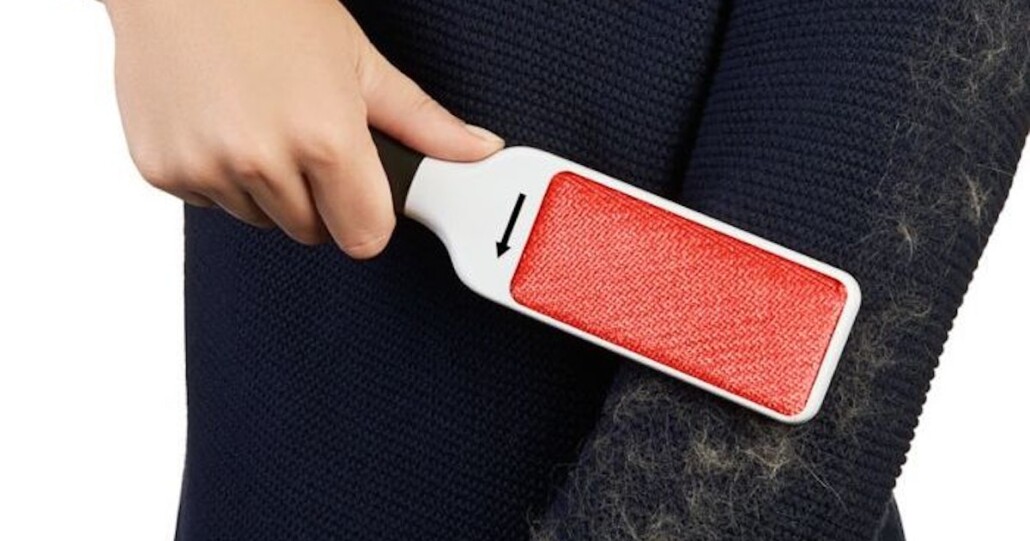
What’s more, lint rollers have the potential to damage your clothing as the adhesive can leave a residue, and the lint roller is really only addressing the outermost surface of the fabric So, while it may look as though a lint roller has been successful in removing detritus from your clothes, it hasn’t gotten beneath the surface, and some of what you see on the roll is actual fibers from your clothing itself.
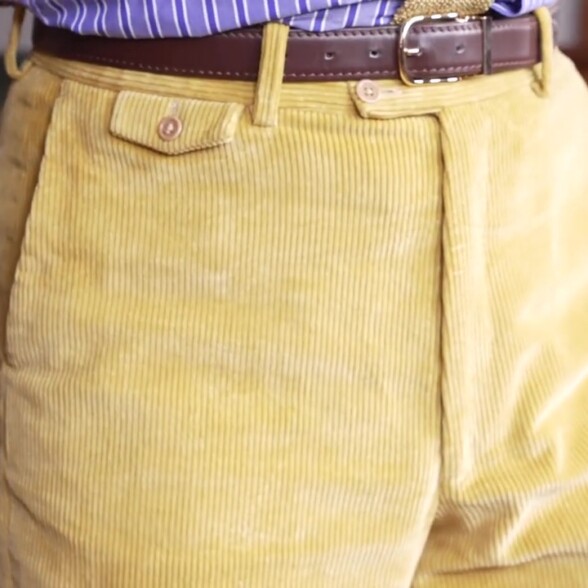
When a Lint Roller Works
All of this isn’t to say that lint rollers have no place whatsoever in your garment care regimen. If you’re attempting to quickly and superficially clean the outermost surface of garments that tend to attract lint or debris—like corduroy, for instance—then a lint roller can be good in a pinch. As an example here, they’ve certainly come in handy for us when we’ve done photo shoots of our Fort Belvedere Stancliffe corduroys, and lint rollers do efficiently remove several types of pet hair, which can certainly be a plus for some people.
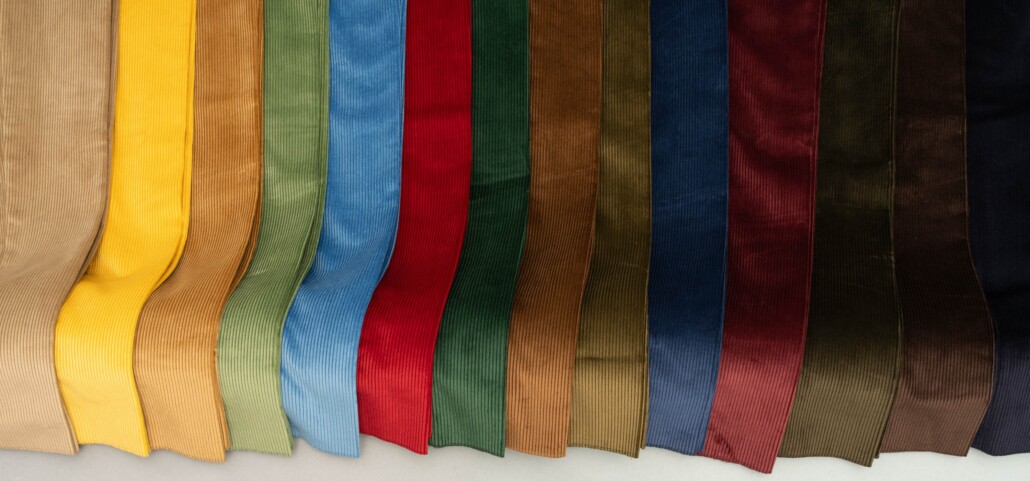
RECOMMENDED
Stancliffe 8-Wale Corduroy Trousers
No matter the season, occasion, or ensemble, Fort Belvedere has corduroy trousers in every color that you could desire. Our material is first fabric-dyed to ensure a rich, deep, and consistent color that penetrates into the fibers themselves to reduce fading. The result is an unparalleled depth of color that you can enjoy for years to come, in an array of colors you will be hard-pressed to find anywhere else.
So, it’s not a bad thing to have one lint roller in your arsenal for occasional touch-ups, but in most cases, a clothes brush is going to be the better investment. Not only that, but it should be a reasonable one, as a decent quality clothes brush should cost you $50 to $100 and can last a lifetime with proper use.
What Is a Clothes Brush?
With all this talk of clothes brushes, we should clarify just what a clothes brush is. Similarly to the humble shoehorn, the clothes brush isn’t a new invention but is, in fact, many decades if not centuries old. Lower-end clothes brushes will have plastic or otherwise synthetic bristles, but clothes brushes of high quality are typically going to have natural hair bristles like horse hair, and of course, prior to the invention of the lint roller, clothes brushes were the principal way for men to give their garment a bit of quick care after a day’s wear.
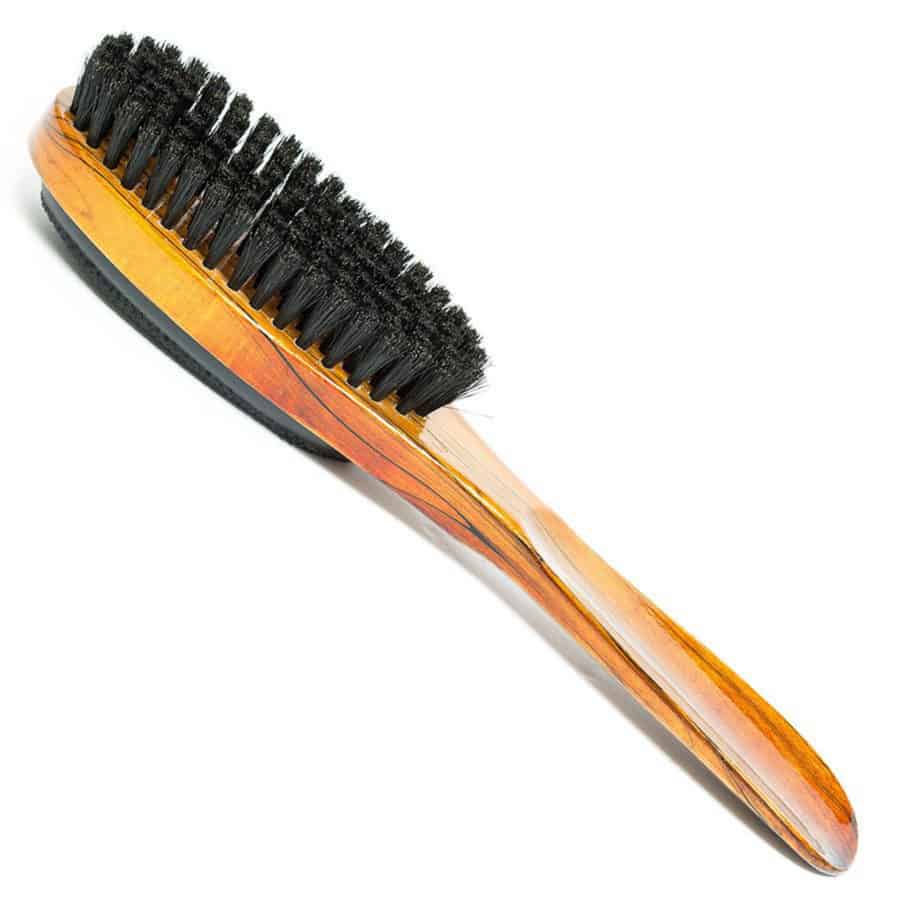
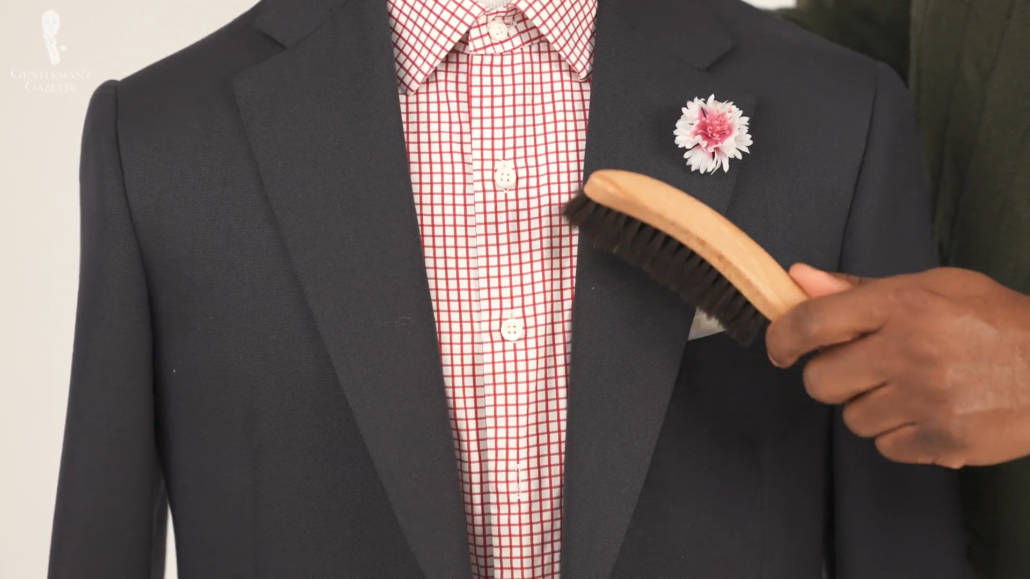
There are also specialist subtypes of clothing brushes on the market—like the thin, curved hat brush, which will keep your classic hats in tiptop shape, and the closely related cashmere comb, which will help to remove peeling from your delicate knitwear. This, by the way, is good to know, as a standard clothing brush can be just a bit harsh for your delicate knits. By the way, if you’d like to learn more about how to properly care for your sweaters, we have a guide on that subject as well.
How to care for knitwear
Why Should I Use a Clothes Brush?
Easy Everyday Maintenance
The next question then is why you should use a clothes brush. Clothes brushes help to remove not just lint but also dust, dirt, hair, and other unwanted substances from your clothing. While garments that are regularly laundered, like shirts, socks, and underwear, probably aren’t going to need much attention from a clothes brush, garments that don’t see laundering as regularly will need this attention. You can think of things like suits, odd jackets, and trousers, or overcoats, for instance. Larger items of clothing like these are more difficult to launder at home—unless you have the right know-how, that is.
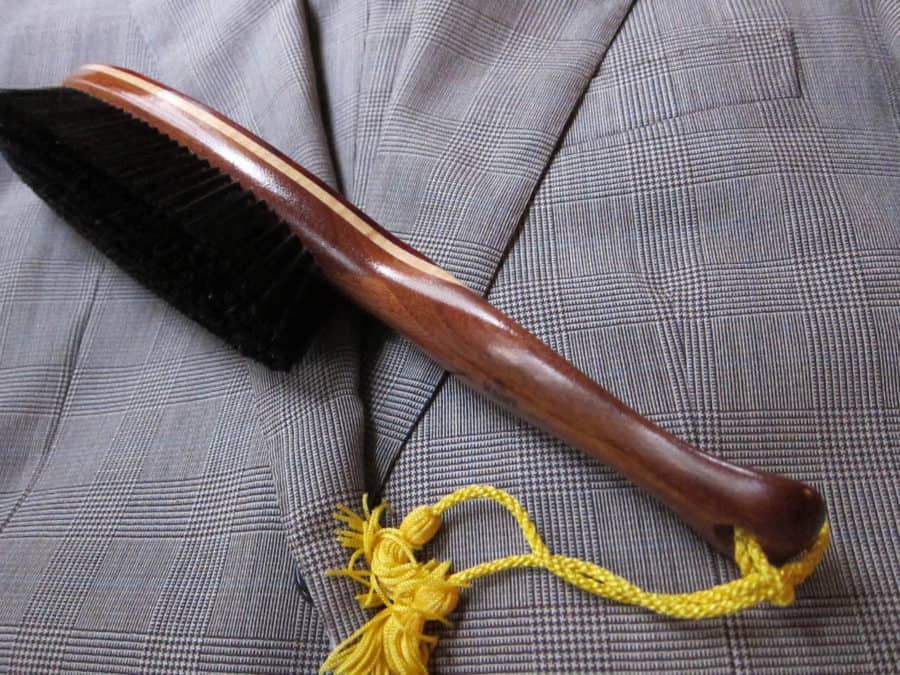
Reduce Unnecessary Trips to the Dry Cleaners
Most men will typically send garments like these to the dry cleaners periodically, but repeated dry cleaning can be harmful to clothing, especially to clothing with fine, delicate fibers as repeated exposure to these chemicals can break those fibers down.
In other words, repeatedly sending these garments to the dry cleaner can shorten their overall lifespan. And not every dry cleaner has the same high standards; you could think of things like lapels that have been pressed completely flat—the bane of three-roll-two lovers everywhere, and of course, there’s the occasional horror story of a garment brought to the dry cleaner that was damaged irreparably.
So, finding a competent dry cleaner is its own investment of time and money, and even when you do find one, you might not necessarily want to bring your garments to them repeatedly for the benefit of your wallet, if nothing else.
So, a clothes brush will allow you to do a lot of the more basic clothing maintenance work at home, drastically cutting down on those bills. The bristles of a clothes brush will lift everyday detritus from your clothing—both at the very surface and below.
Protect Your Clothes from Moths
This is particularly important as naturally occurring dirt is what attracts clothes moths, otherwise known as the “dreaded destroyer of clothes,” and clothes brushes can also remove foreign substances that contribute to clothing having an off smell over time.

Clothes Moth
Thoroughly cleaning your garments will prevent clothes moths. Dry cleaning is an effective method of killing moth larvae or simply using a clothes brush will sweep away these species from your garments!
Restore the Nap of the Fabric
Finally here, clothes brushes, when used properly, will restore the nap of the cloth, making your clothing look fresh out of the box each time you wear it so that you don’t have to buy a new jacket every time you go out.
Can I Use a Shoe Brush Instead of a Clothes Brush? No!
Here’s a question that those new to the world of menswear often ask: “Can’t I just use a shoe brush to clean my clothes?” The answer is: Unless you want to look like you’ve just had a brawl with your cobbler, then definitely not.
Assuming you’ve been using your shoe brush to properly take care of your shoes, then naturally, that brush is probably going to have a good amount of dirt and shoe polish on it, and even if you are using a brand-new shoe brush, the structure of the brush and the types of bristles used aren’t going to give you the best results for clothing care.
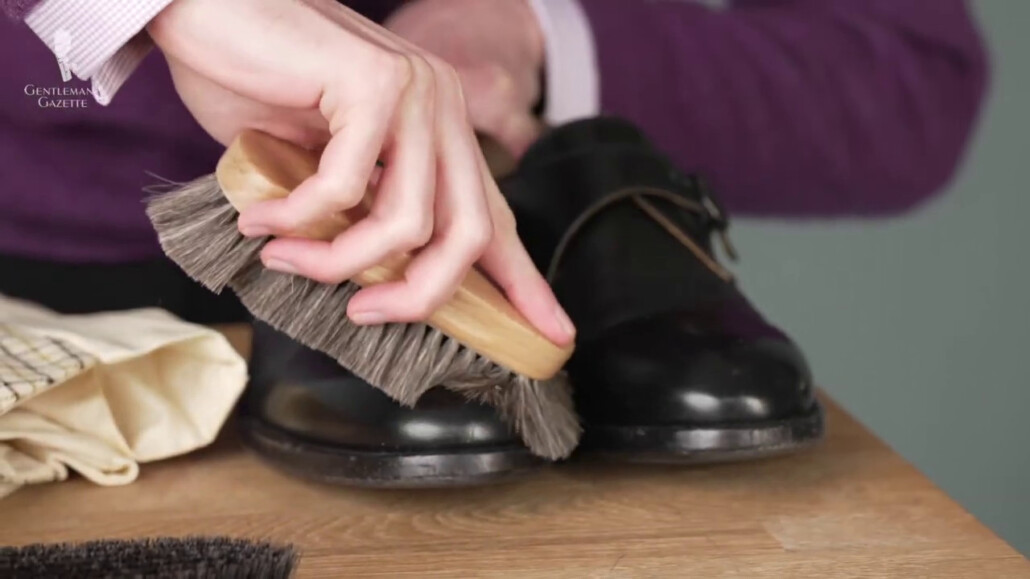
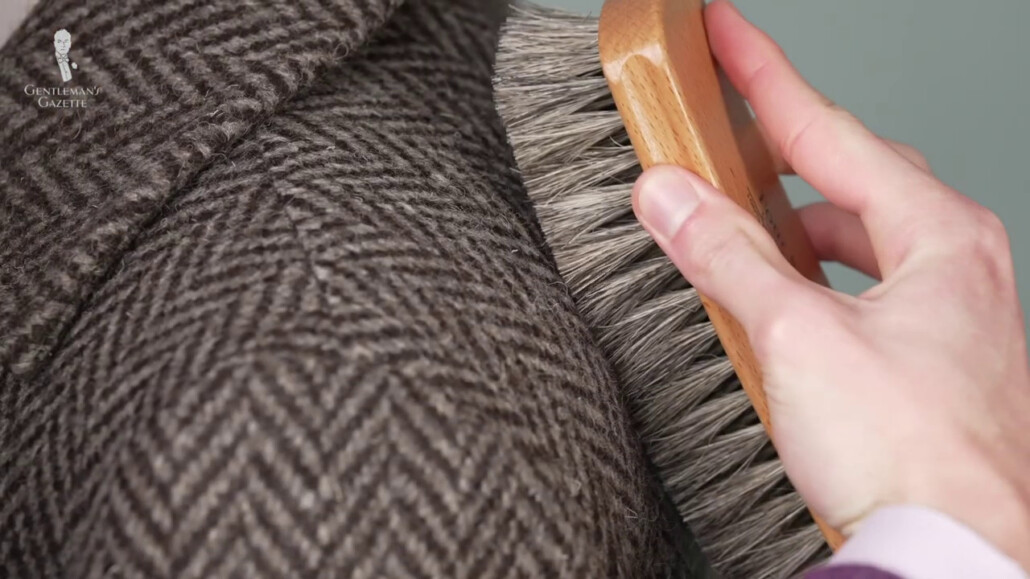
If you were trying to use something like the coarser, stiffer brush used for getting dirt out of the welt crevices. This would be likely to do some serious damage to your clothing; meanwhile, finer shoe brushes designed for giving that finished gleaming shine to your shoes might just glide over the surface of your clothing without really doing much cleaning at all.
Essentially, you want to look for specific, dedicated brushes for each part of your garment care routine. Clothing brushes for your clothes, hat brushes for your hats, and shoe brushes for your shoes. Pretty simple when you say it that way, isn’t it?
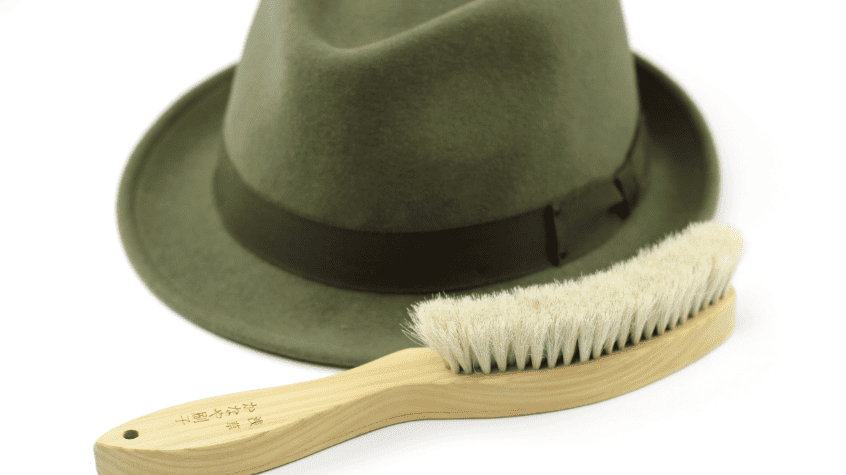
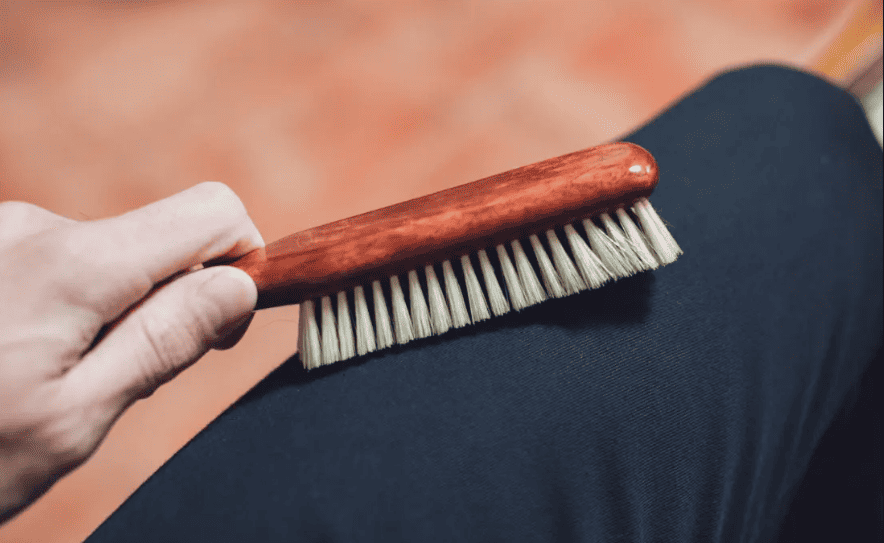
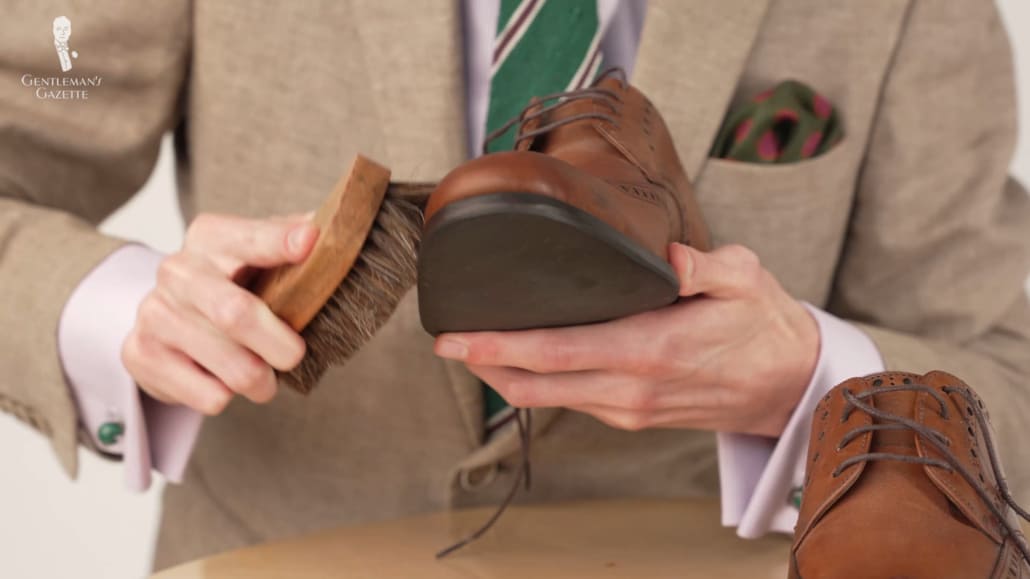
What Should I Look For in a Clothes Brush?
If you’re sold on the idea of a clothes brush, then, let’s next cover what you should look for in a quality clothes brush. We’ll quickly go over three factors that you should keep in mind and the first of these is a distinct handle and head to the brush.
1. A Separate Handle and Head
Unlike when polishing shoes, you’ll be covering a larger overall surface area when brushing your clothes so you’ll want a dedicated handle that you can keep a good ergonomic grip on.
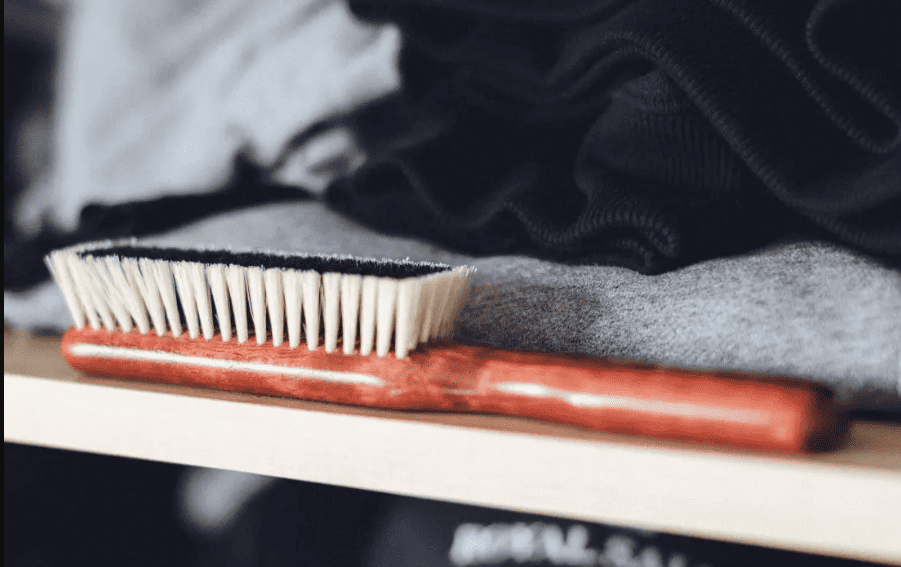
Handleless clothes brushes like this one from Arterton do exist, and they do have their place—if you’re traveling, for instance, and need a clothes brush that doesn’t take up a lot of space—and there are several clothes brushes out there that incorporate moving parts, foldable shoe horns, and other devices. But, in our experience, these tend to be flimsy and over-engineered and more likely to break over time. So, in addition to having a distinct handle and head, that brings us to our second point to look for, which is a hardwood body.
2. A Hardwood Body
There’s really no substitute for a well-made, wooden clothes brush, and choosing something like a brush made from beechwood should give you excellent longevity.
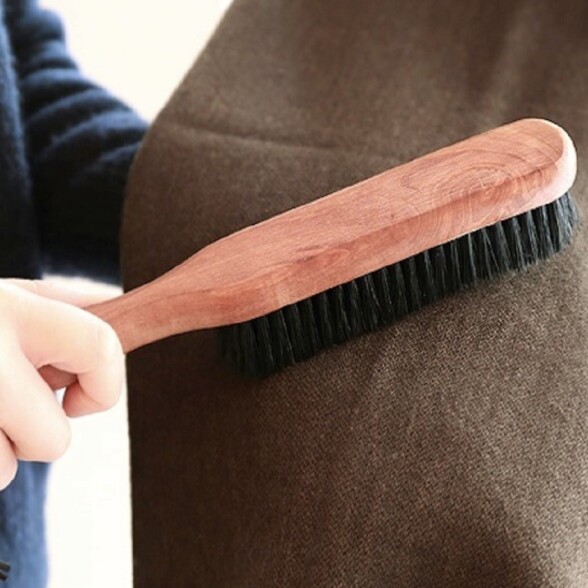
Hardwood body for a clothes brush
This should give you a good balanced weight to the brush that will make using it comfortable for your hand.
3. Natural Bristles
Finally here, the third point to look for in a quality clothes brush is natural bristles. Horsehair bristles are the go-to when it comes to clothes brushes as they’ve got just the right flexibility to get under and around different fibers of your clothing and get out dirt and detritus without actually damaging the fibers themselves.
There have been recent advancements in the world of synthetic bristles, which are bringing them closer in quality to their natural brethren, but most of the time, we’d still advocate for finding a brush with natural bristles. Brushes with boar hair bristles are also available and boar hair is typically tougher and stiffer than horse hair. So, a brush made from boar bristles will perform better on hardier garments like tweed suits or overcoats, and you can also find brushes with a blend of horse and boar hair; in fact, you’re more likely to see brushes with boar hair blended in as opposed to just being used on its own as boat hair could be too tough for many garments.
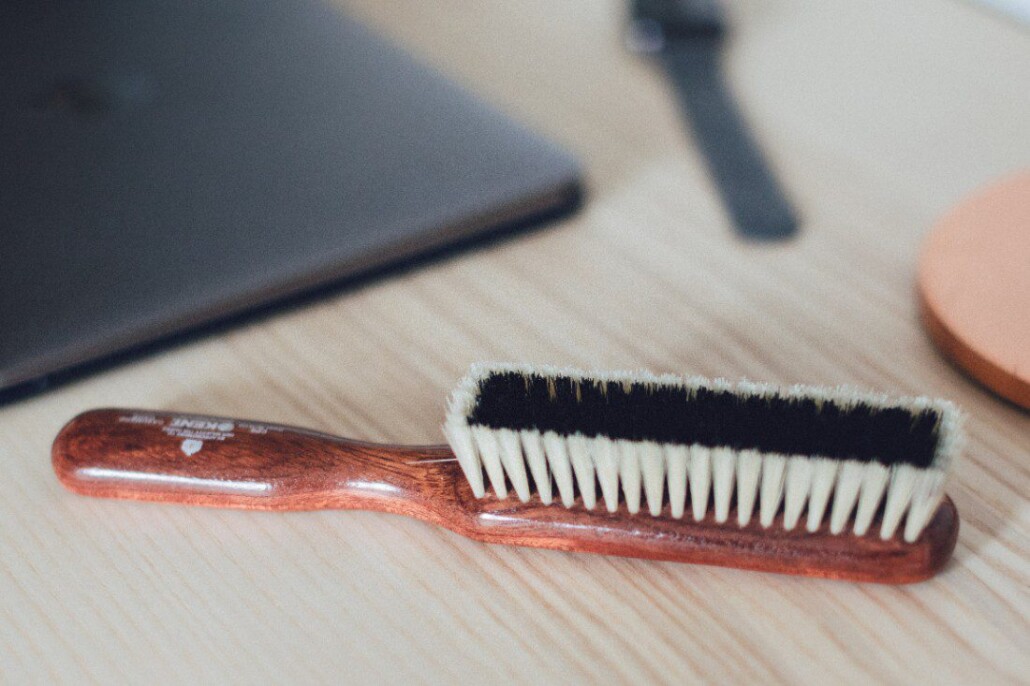
In general, though, a horse hair brush is going to be your best bet for most garment types.
How to Properly Use a Clothes Brush
Firstly, before breaking out the brush, it’s a good idea to put the garment in question on a good sturdy hanger or, better yet, a tailor’s form or silent valet. Of course, these latter options aren’t going to be available for everyone, so a good, sturdy hanger will do just fine.
Place the Garment on a Hanger, Silent Valet, or Form
Putting your garment on a hanger will allow you to see it in its entirety and focus on areas that might need attention and that would be hard to reach if the garment were laid flat. For instance, think of places like under the arms or under the collar. For best results, you’ll want to employ short, brisk, flicking motions as you brush.
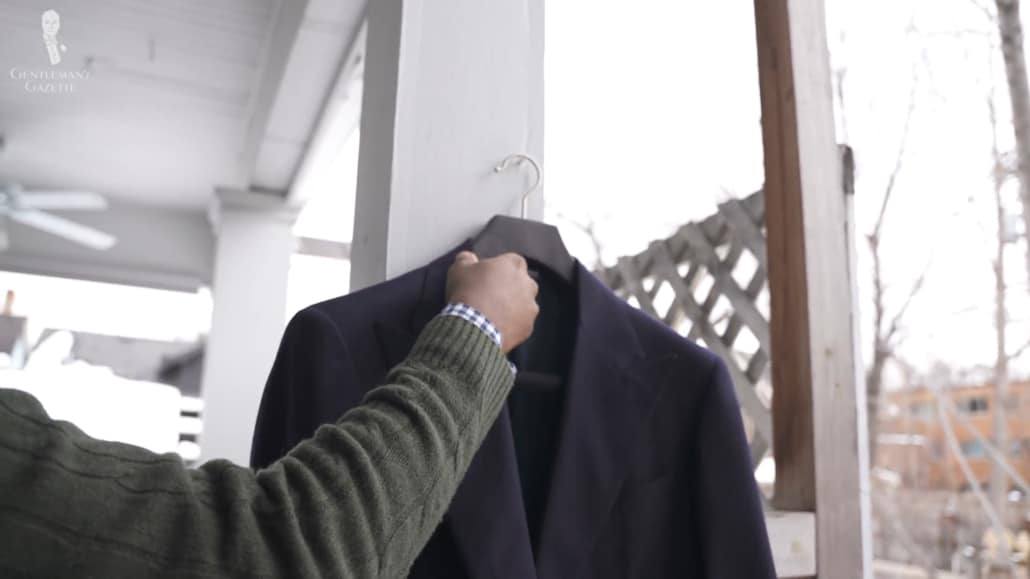
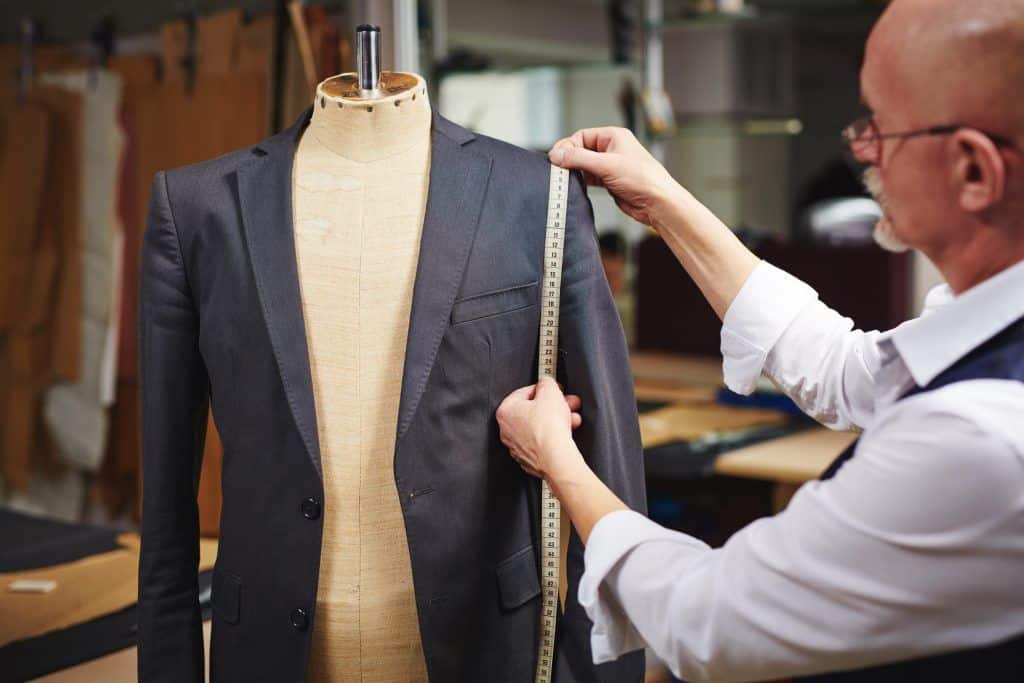
Employ the Correct Brushing Motion
Remember, it’s not a toothbrush, so don’t use a scrubbing motion. This could have a detrimental effect by prematurely weakening the fibers in your clothes. This advice also applies to larger and longer garments like trousers and overcoats. You may be tempted to employ longer strokes here, but don’t do this as you’ll run the risk of pulling your garments out of shape or, even worse, they could tear at the seams. So, again, for best results, stick to short, brisk motions begin by brushing against the nap of the fabric, which is the direction in which the fibers lie flattest.
By doing this, you’re going to expel the highest amount of dirt, dust, and other debris. Repeat this against the nap brushing until you no longer see small clouds of dust coming off of the fabric. Of course, brushing under strong and direct light here will help you to determine this point.
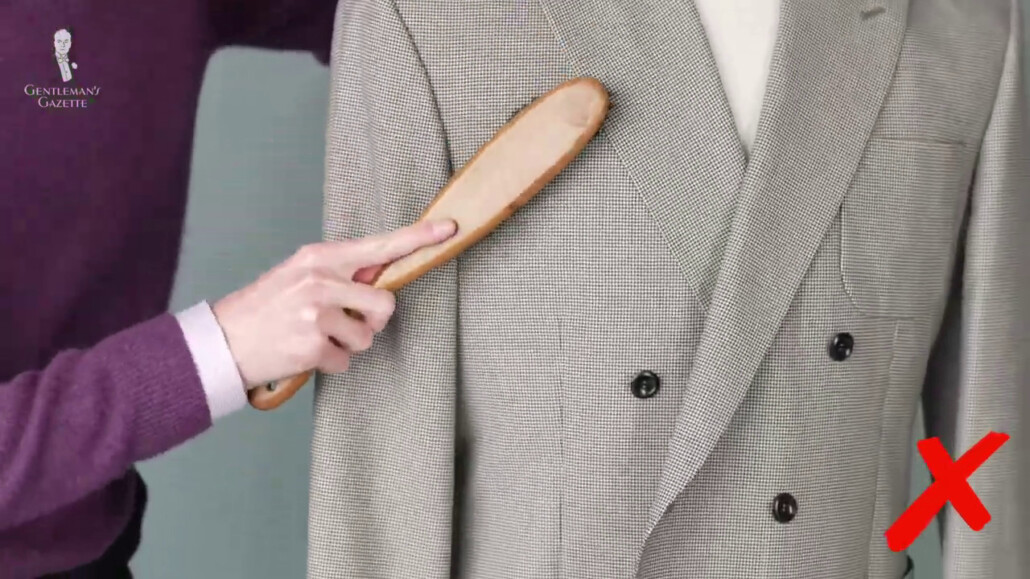
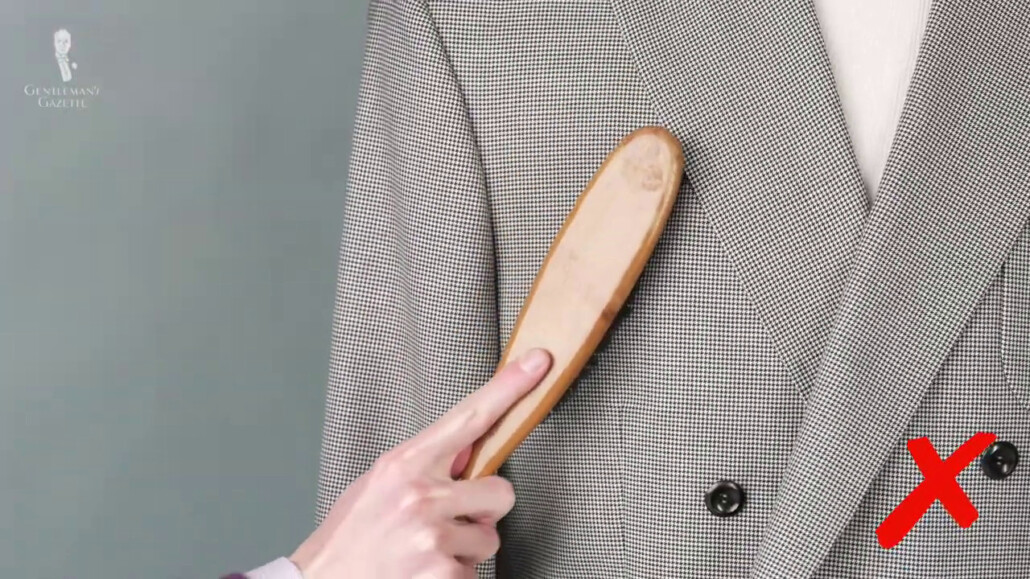
Once you’ve finished brushing the garment against the nap, then you should brush the garment again in the direction of the nap. This will return the fibers to their natural state, making your garment look as good as new.
Consider a Quick Brush Before Leaving Your Home
You can also give yourself a quick once-over with a clothes brush while you’ve got the garments you want to brush on. This, of course, won’t give you results as good as brushing them when they’re on a separate hanger, but it’s still better than no brushing at all. Indeed, this method was often employed by valets and can still be seen offered in some barber shops. The best practice here would be to give each of your garments a quick brush when you’ve returned them to their hangers at the end of the day.
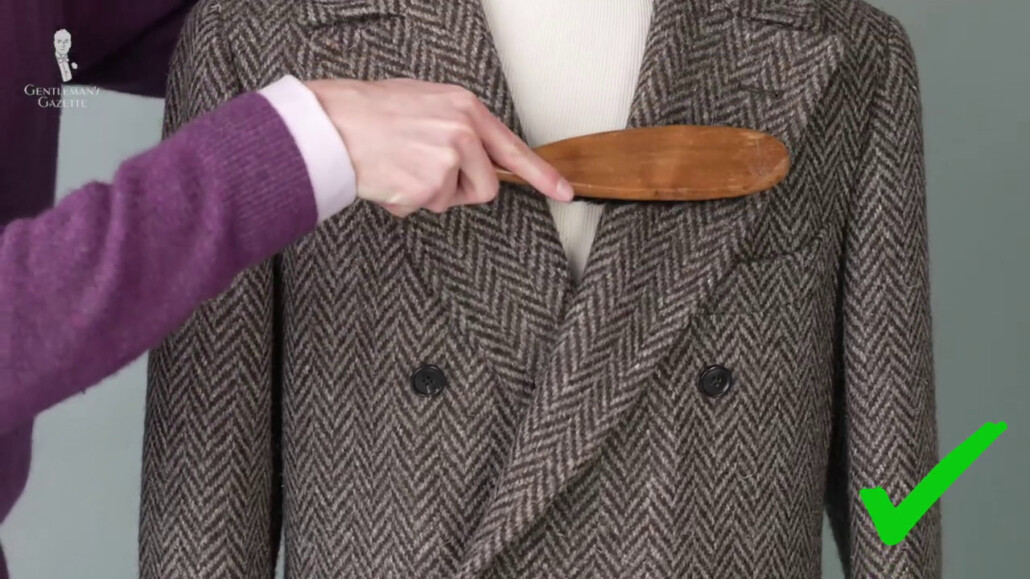
Employing the old adage of “little and often” when it comes to clothing care is a surefire way to make sure that your garments have their maximum longevity, and using a high-quality clothes brush will mean that the act of cleaning your clothing will be more pleasurable for you as well.
Conclusion
When it comes to garment care there are few Investments as practical and desirable as a good clothes brush. While lint rollers will probably continue to dominate the market, not everything new is necessarily better. The classics have a tendency to stick around for a reason, after all.
So, if you’ve got a clothes brush, how do you incorporate it into your garment care routines? Let us know in the comments below, and we’ll see if there are any techniques that we should brush up on.
Outfit Rundown
Today, I’m wearing a casual outfit, good for sitting around the house or doing some garment care. The central element, of course, is my berry-colored, v-neck, cashmere sweater. I probably wouldn’t want to use a standard clothes brush on this sweater as it is on the more delicate side. Rather, a cashmere comb would be a better choice here.
I’m wearing the sweater over a shirt from Charles Tyrwhitt in a small houndstooth that they call “puppy tooth” in lilac and white. The shirt does have French cuffs, but I’m wearing simple black links, and I’ve got the cuffs configured in a barrel style to fit more easily under the sweater sleeve.
Grounding the outfit are my trousers in plain black, and my shoes are also black. They are single monk straps from the brand Velasca. In the outdoor footage you’re seeing, I’m wearing one of my trusty flat caps in a blue and off-white houndstooth pattern from the Polish brand Poszetka.
The fragrance I’m wearing today is Guerlain’s Vetiver, which I appreciate the scent of, and the green, accents of the bottle also harmonized with one element of my outfit I haven’t mentioned yet—my socks in two-tone, shadow-stripes from Fort Belvedere in dark green and purple.
For the socks I’m wearing, as well as a wide array of other classic men’s accessories, corduroy trousers, and fragrances from the Roberto Ugolini collection, you can take a look at the Fort Belvedere shop.
FAQ
Why should I use a clothes brush instead of a lint roller?
Clothes brushes are designed to gently remove lint, dust, and hair without damaging the fabric. Unlike sticky lint rollers that can leave residue, clothes brushes provide a more sustainable and gentle way to care for your garments.
How does a clothes brush preserve my clothing better than a lint roller?
A clothes brush gently lifts and removes debris from the fibers of your clothing. This action not only avoids harsh adhesive contact with delicate fabrics but also helps maintain the structural integrity of the garment by not pulling or stretching the fibers as some lint rollers might do.
Can clothes brushes be used on all types of fabrics?
Yes, clothes brushes can be safely used on a variety of fabrics, from wool suits to delicate cashmere. However, it’s essential to choose the right type of brush for different fabrics – softer bristles for fine materials and stiffer bristles for heavier fabrics.
Are clothes brushes environmentally friendly?
Indeed, clothes brushes are an eco-friendly alternative to lint rollers. They don’t require any disposable sheets and can last for many years with proper care, reducing waste significantly.
How do I clean and maintain a clothes brush?
To clean your clothes brush, simply remove any accumulated lint and hair by hand or using a comb. For deeper cleaning, you can wash the bristles with mild soap and water, then allow it to air dry before the next use.
Aren’t lint rollers cheaper than clothes brushes?
Initially, lint rollers may seem cheaper due to their lower upfront cost. However, they require frequent refills, which adds up over time. Clothes brushes, on the other hand, have a higher initial price but do not incur ongoing costs. Considering their durability and the absence of refill expenses, clothes brushes are more cost-effective in the long run.
Is a clothes brush economical in the long run?
While a quality clothes brush may have a higher initial cost compared to a lint roller, it is far more economical over time. A well-maintained brush can last for decades, eliminating the need for continuous purchases of lint roller refills.
Will a clothes brush work as quickly as a lint roller?
While a clothes brush may require a bit more time and technique, the results are superior. With practice, you’ll find brushing your garments can be just as quick as using a lint roller, and far more satisfying considering the benefits to your clothing’s longevity.
For those who value preserving their classic menswear, investing in a good quality clothes brush is a wise decision for both your wardrobe and the environment.
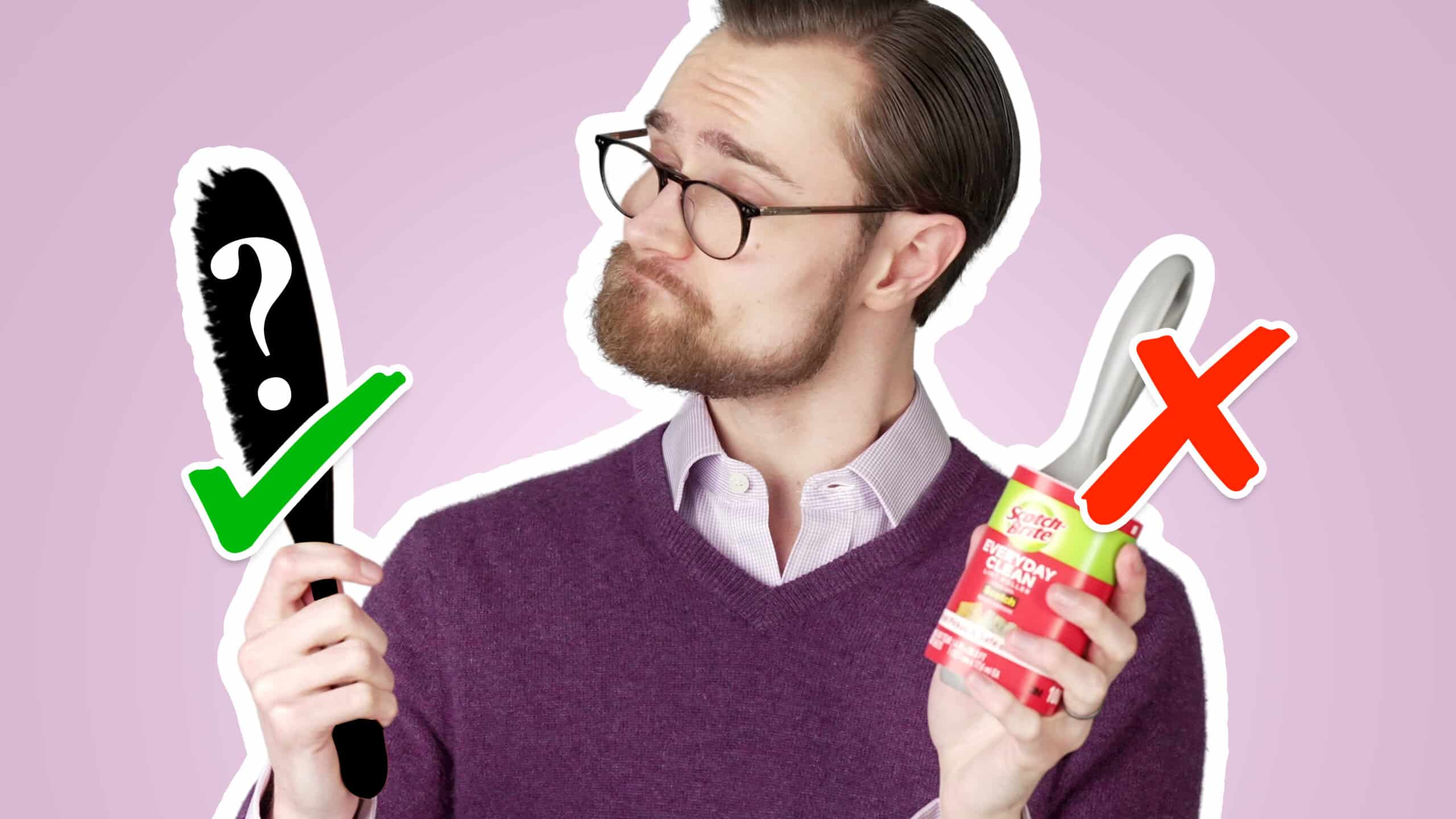

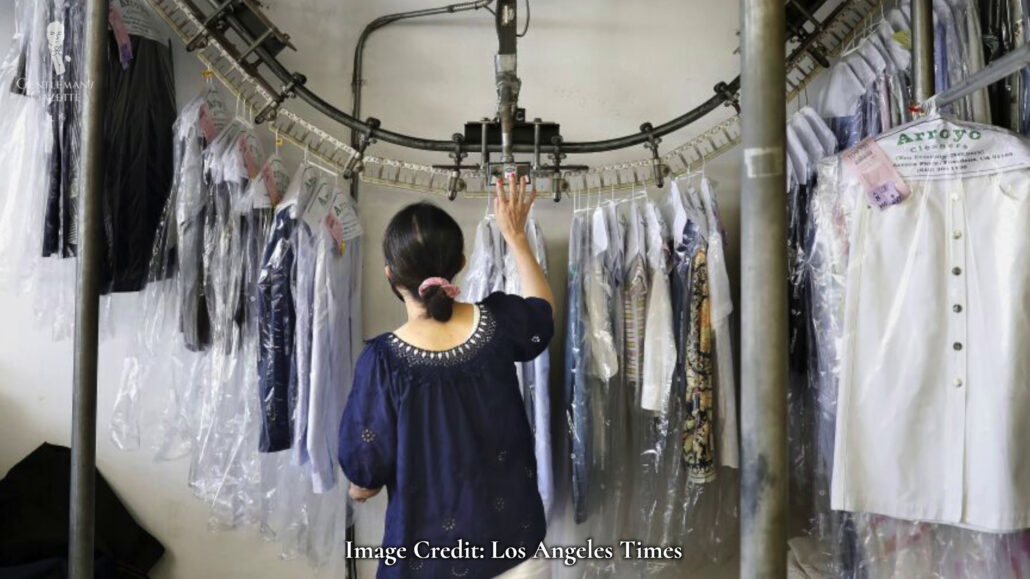
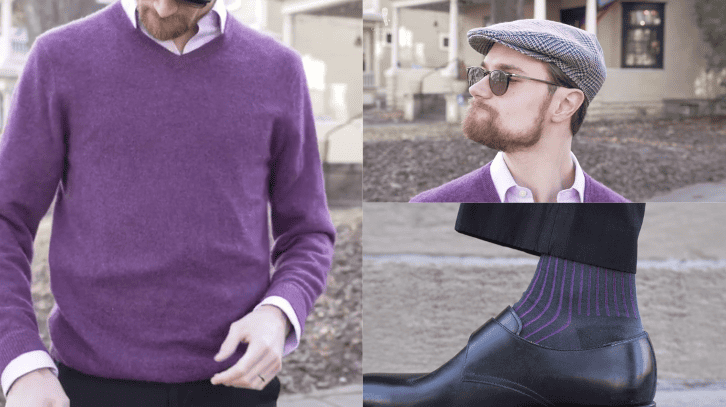
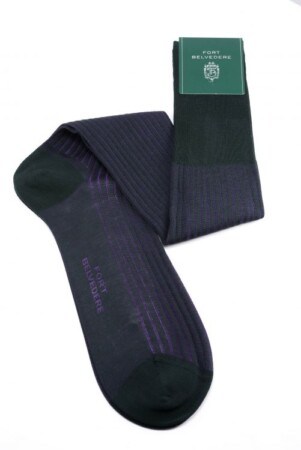
I wonder if the horsehair clothes brush is partially superior because the fiber in horse hair is similar in terms to its position on the triboelectric scale to wool. Hence it will tend to adhere to the same kinds of detritus that will adhere to wool.
Just might be getting myself one. Thanks!